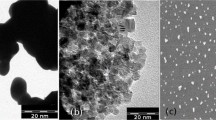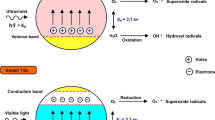Abstract
Photodynamic therapy has been used to inactivate microorganisms through the use of targeted photosensitizers. Although the photoinactivation of microorganisms has already been studied under different conditions, a systematic evaluation of irradiation characteristics is still limited. The goal of this study was to test how the light dose, fluence rate and irradiation source affect the viral photoinactivation of a T4-like sewage bacteriophage. The experiments were carried out using white PAR light delivered by fluorescent PAR lamps (40 W m−2), sun light (600 W m−2) and an halogen lamp (40–1690 W m−2). Phage suspensions and two cationic photosensitizers (Tetra-Py+-Me, Tri-Py+-Me-PF) at concentrations of 0.5, 1.0 and 5.0 μM were used. The results showed that the efficacy of the bacteriophage photoinactivation is correlated not only with the sensitizer and its concentration but also with the light source, energy dose and fluence rate applied. Both photosensitizers at 5.0 μM were able to inactivate the T4-like phage to the limit of detection for each light source and fluence rate. However, depending of the light parameters, different irradiation times are required. The efficiency of photoinactivation is dependent on the spectral emission distribution of the light sources used. Considering the same light source and a fixed light dose applied at different fluence rates, phage inactivation was significantly higher when low fluence rates were used. In this way, the light source, fluence rate and total light dose play an important role in the effectiveness of the antimicrobial photodynamic therapy and should always be considered when establishing an optimal antimicrobial protocol.
Similar content being viewed by others
Notes and References
M. Jemli, Z. Alouini, S. Sabbahi, and M. Gueddari, Destruction of fecal bacteria in wastewater by three photosensitizers, J. Environ. Monit., 2002, 4, 511–516.
M. Magaraggia, F. Faccenda, A. Gandolfi, and G. Jori, Treatment of microbiologically polluted aquaculture waters by a novel photochemical technique of potentially low environmental impact, J. Environ. Monit., 2006, 8, 923–931.
C. M. B. Carvalho, J. P. C. Tomé, M. A. F. Faustino, M. G. P. M. S. Neves, A. C. Tomé, J. A. S. Cavaleiro, L. Costa, E. Alves, A. Oliveira, A. Cunha, and A. Almeida, Antimicrobial photodynamic activity of porphyrin derivatives: Potential application on medical and water disinfection, J. Porphyrins Phthalocyanines, 2009, 13, 574–577.
F. H. E. Schagen, A. C. E. Moor, S. C. Cheong, S. J. Cramer, H. Ormondt, A. J. Eb, T. M. A. R. Dubbelman, and R. C. Hoeben, Photodynamic treatment of adenoviral vectors with visible light: an easy and convenient method for viral inactivation, Gene Ther., 1999, 6, 873–881.
A. N. Vzorov, D. W. Dixon, J. S. Trommel, L. G. Marzilli, and R. W. Compans, Inactivation of human immunodeficiency virus type 1 by porphyrins, Antimicrob. Agents Chemother., 2002, 46, 3917–3925.
S. J. Wagner, Virus Inactivation in Blood Components by Photoactive Phenothiazine Dyes, Transfus. Med. Rev., 2002, 16, 61–66.
B M. J. Casteel, K. Jayaraj, G. Avram, L. M. Bail, and M. D. Sobsey, Photoinactivation of hepatitis A virus by synthetic porphyrins, Photochem. Photobiol., 2004, 80, 294–300.
B. Williams Horowitz, B. Williams, and S. Rywkin, Inactivation of viruses in blood with aluminium phthalocyanines derivatives, Transfusion, 1991, 31, 102–108.
E. M. P. Silva, F. Giuntini, M. A. F. Faustino, J. P. C. Tomé, M. G. P. M. S. Neves, A. C. Tomé, A. M. S. Silva, M. G. Santana-Marques, A. J. Ferrer-Correia, J. A. S. Cavaleiro, M. F. Caeiro, R. R. Duarte, S. A. P. Tavares, I. N. Pegado, B. d’Almeida, A. P. A. De Matos, and M. L. Valdeira, Synthesis of cationic beta-vinyl substituted meso-tetraphenylporphyrins and their in vitro activity against herpes simplex virus type 1, Bioorg. Med. Chem. Lett., 2005, 15, 3333–3337.
J. P. C. Tomé, E. M. P. Silva, A. Pereira, C. M. A. Alonso, M. A. F. Faustino, M. G. P. M. S. Neves, A. C. Tomé, J. A. S. Cavaleiro, S. A. P. Tavares, R. R. Duarte, M. F. Caeiro, and M. L. Valdeira, Synthesis of neutral and cationic tripyridylporphyrin-D-galactose conjugates and the photoinactivation of HSV-1, Bioorg. Med. Chem., 2007, 15, 4705–4713.
J. P. C. Tomé, M. G. P. M. S. Neves, A. C. Tomé, J. A. S. Cavaleiro, A. F. Mendonça, I. N. Pegado, R. Duarte, and M. L. Valdeira, Synthesis of glycoporphyrin derivatives and their antiviral activity against herpes simplex virus types 1 and 2, Bioorg. Med. Chem., 2005, 13, 3878–3888.
W. Wainwright, Photoantimicrobials - a PACT against resistance and infection,, Drugs Future, 2004, 29, 85–93.
J. Lenard, and R. Vanderoef, Photoinactivation of influenza virus fusion and infectivity by rose bengal, Photochem. Photobiol., 1993, 58, 527–531.
H. Abe, K. Ikebuchi, S. J. Wagner, M. Kuwabara, N. Kamo, and S. Sekiguchi, Potential involvement of both type I and type II mechanisms in Ml 13 virus inactivation by methylene blue photosensitization, Photochem. Photobiol., 1997, 66, 204–208.
J. V. Lee, S. R. Dawson, S. Ward, S. B. Surman, and K. R. Neal, Bacteriophages are a better indicator of illness rates than bacteria amongst users of a water course fed by a lowland river, Water Sci. Technol., 1997, 35, 165–170.
S. J. Wagner, A. Skripchenko, J. W. F. D. Robinette, and L. Cincotta, Factors affecting virus photoinactivation by a series of phenothiazine dyes, Photochem. Photobiol., 1998, 67, 343–398.
M. Egyeki, G. Turóczy, Zs. Majer, K. Tóth, A. Fekete, Ph. Maillard, G. Csík, Photosensitized inactivation of T7 phage as surrogate of non-enveloped DNA viruses: efficiency and mechanism of action., Biochim. Biophys. Acta, Gen. Subj., 2003, 1624, 115–124.
K. Zupán, L. Herényi, K. Tóth, Z. Majer, G. Csík, Binding of cationic porphyrin to isolated and encapsidated viral DNA analyzed by comprehensive spectroscopic methods, Biochemistry, 2004, 43, 9151–9159.
M. Embleton, S. Nair, W. Heywood, D. Menon, B. Cookson, and M. Wilson, Development of a novel targeting for lethal photosensitization of antibiotic-resistant strains of Staphylococcus aureus, Antimicrob. Agents Chemother., 2005, 49, 3690–3696.
A. Almeida, A. Cunha, N. C. M. Gomes, E. Alves, L. Costa, M. A. F. Faustino, Phage therapy and photodynamic therapy: low environmental impact approaches to inactivate microorganisms in fish farming plants, Mar. Drugs, 2009, 7, 268–313.
L. Costa, E. Alves, C. M. B. Carvalho, J. P. C. Tomé, M. A. F. Faustino, M. G. P. S. Neves, A. C. Tomé, J. A. S. Cavaleiro, A. Cunha, and A. Almeida, Sewage bacteriophage photoinactivation by cationic porphyrins: a study of charge effect, Photochem. Photobiol. Sci., 2008, 7, 415–422.
E. Reddi, M. Ceccon, G. Valduga, G. Jori, J. C. Bommer, F. Elisei, L. Latterini, and U. Mazzucato, Photophysical properties and antibacterial activity of meso-substituted cationic porphyrins, Photochem. Photobiol., 2002, 75, 462–470.
Z. Lukšiene, New approach to inactivation of harmful and pathogenic microorganisms by photosensitization, Food Technol. Biotechnol., 2005, 43, 411–418.
Z. Lukšiene, and A. Zukauskas, Prospects of photosensitization in control of pathogenic and harmful micro-organisms, J. Appl. Microbiol., 2009, 107, 1415–1424.
R. A. Prates, E. G. da Silva, A. M. Yomada, Jr., L. C. Suzuki, C. R. Paula, and M. S. Ribeiro, Light parameters influence cell viability in antifungal photodynamic therapy in a fluence and rate fluence-dependent manner, Laser Phys., 2009, 19, 1038–1044.
C. Kasturi, and M. S. Platz, Inactivation of lambda phage with 658 nm light using a DNA binding porphyrin sensitizer, Photochem. Photobiol., 1992, 56, 427–429.
E. Alves, L. Costa, C. M. B. Carvalho, J. P. C. Tomé, M. A. F. Faustino, M. G. P. S. Neves, A. C. Tomé, J. A. S. Cavaleiro, A. Cunha, S. Mendo, and A. Almeida, Charge effect on the photoinactivation of Gram-negative and Gram-positive bacteria by cationic meso-substituted porphyrins, BMC Microbiol., 2009, 9, 70–83.
A. Schindl, B. Rosado-Sholosser, and F. Trautinger, Reciprocity regulation in photobiology: an overview [in German]., Hautarzt, 2001, 52, 779–785.
W. Schmidt, Optical Spectroscopy in Chemistry and Live Sciences, Wiley-VCH, Weinheim, 2005.
A. Oliveira, A. Almeida, C. M. B. Carvalho, J. P. C. Tomé, M. A. F. Faustino, M. G. P. M. S. Neves, A. C. Tomé, J. A. S. Cavaleiro, and A. Cunha, Porphyrin derivatives as photosensitizers for the inactivation of Bacillus cereus endospores, J. Appl. Microbiol., 2009, 106, 1986–1995.
M. E. Milanesio, M. G. Alvarez, J. J. Silber, V. Rivarola, and E. N. Durantini, Photodynamic activity of monocationic and non-charged methoxyphenylporphyrin derivatives in homogeneous and biological media, Photochem. Photobiol. Sci., 2003, 2, 926–933.
D. Lazzeri, M. Rovera, L. Pascual, and E. N. Durantini, Photodynamic studies and photoinactivation of Escherichia coli using meso-substituted cationic porphyrin derivatives with asymmetric charge distribution, Photochem. Photobiol., 2004, 80, 286–293.
D. A. Caminos, M. B. Spesia, and E. N. Durantini, Photodynamic inactivation of Escherichia coli by novel meso-substituted porphyrins by 4-(3-N,N,N-trimethylammoniumpropoxy)phenyl and 4-(trifluoromethyl) phenyl groups, Photochem. Photobiol. Sci., 2006, 5, 56–65.
L. F. Paula, R. O. Santos, H. D. Menezes, J. R. Britto, J. B. Vieira, Jr., P. P. Gomtijo, Filho, and C. A. Oliveira, A comparative study of irradiation systems for photoinactivation of microorganisms, J. Braz. Chem. Soc., 2009, 1–7.
F. Ghetti, and G. Checcucci, Action spectroscopy In R. Jennings, G. Zucchelli, F. Ghetti and G. Colombetti, (ed.) Light as an energy source and information carrier in plant physiology. NATO ASI Series A287, Plenum Press, New York, 1996, pp. 275–283.
Y. Qin, X. Luan, L. Bi, G. He, X. F. Bai, C. Zhou, and Z. Zhang, Toluidine blue-mediated photoinactivation of peridontal pathogens from supragingival plaques, Lasers Med. Sci., 2007, 23, 49–54.
F. Gabor, K. Szocs, P. Maillard, and G. Csik, Photobiological activity of exogenous and endogenous porphyrin derivatives in Escherichia coli and Enterococcus hirae cells, Radiat. Environ. Biophys., 2001, 40, 145–151.
J. P. Tomé, M. G. Neves, A. C. Tomé, J. A. Cavaleiro, M. Soncin, M. Magaraggia, S. Ferro, and G. Jori, Synthesis and antibacterial activity of new poly-S-lysine-porphyrin conjugates, J. Med. Chem., 2004, 47, 6649–6652.
A. P. J. Maestrin, A. O. Ribeiro, A. C. Tedesco, C. R. Neri, F. S. Vinhado, O. A. Serra, P. R. Martins, Y. Iamamoto, A. M. G. Silva, A. C. Tomé, A novel chlorin derivative of meso-tris(pentafluorophenyl)-4-pyridylporphyrin: Synthesis, photophysics and photochemical properties., J. Braz. Chem. Soc., 2004, 15, 923–930.
J. Sambroook, E. F. Fritsch, and T. Maniatis, Bacteriophage λ vectors, In Molecular Cloning. A Laboratory Manual, (Eds.) J. Sambroook, E. F. Fritsch, T. Maniatis, Second Edition, Cold Spring Harbor Laboratory Press, New York, 1989.
M. H. Adams, Bacteriophages, Interscience, New York, 1959.
Author information
Authors and Affiliations
Corresponding authors
Rights and permissions
About this article
Cite this article
Costa, L., Carvalho, C.M.B., Faustino, M.A.F. et al. Sewage bacteriophage inactivation by cationic porphyrins: influence of light parameters. Photochem Photobiol Sci 9, 1126–1133 (2010). https://doi.org/10.1039/c0pp00051e
Received:
Accepted:
Published:
Issue Date:
DOI: https://doi.org/10.1039/c0pp00051e




